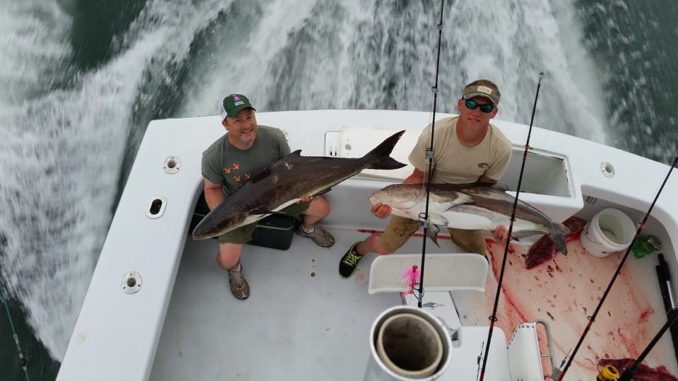
Bucktails tipped with soft plastics have been ticket for anglers sight-casting to fish
Capt. Karl Helmkamp of Fistful Sportfishing in Manteo said the cobia fishing around Oregon Inlet is about as good as it gets, and it’s a rare trip when his parties don’t have multiple fish and at least one large enough to earn a citation.
Helmkamp said he is finding feeding fish from just beyond the breakers out to about 2 ½ miles off the beach, but more are moving to deeper water.
The great majority of cobia are being caught sight-fishing, so Helmkamp has been doing most of his damage when the sun is well up in the sky and he can see down in the water.
“This is fun fishing and angler-intensive once fish are spotted,” Helmkamp said. “Most of the time the fisherman sees the fish he is casting to. Even when he doesn’t see the fish, he sees the bait ball and has a target. The fisherman works the rod and reel and sets the hook when the fish strikes. Once the fish strikes, the fisherman is locked in for a fight that might last up to a half hour, depending on the size of the fish.”
Helmkamp (252-395-1907) is using a combination of 2- and 3-ounce Bomber Cobia jigs, and he also carries live eels for when cobia don’t respond to the jigs. He said the cobia have been pretty aggressive so far and have readily gulped down the jigs. Some days cobia like bright colors and some days not, so he uses a mixture of orange, white, pink and brown. Helmkamp tips the jigs with squid, squid strips or large curlytail grubs. When he uses eels, he fishes them on a bare 8/0 circle hook and hooks the eel from bottom to top through both jaws.
The fishing tackle and rig is simple; he uses stout spinning outfits because they are easier for most fishermen to cast. He fills the reel with 80-pound braid, then adds a 4-foot leader of 60- or 80-pound fluorocarbon. The jig or circle hook is tied to the end of the fluorocarbon.
“Cobia are curious,” Helmkamp said. “They usually don’t run at the first splash, and unless they are spooked bad, they’ll usually just run off a little and then turn and come back. There may be some single fish, but they usually swim in pairs or small packs, and many times we hook doubles, with triples and quads possible. It can get really exciting.”
Helmkamp said most of his parties are returning with at least one or two citation-sized fish (40 pounds or up); one day last week, he had two trips that produced 14 citation fish, all weighing more than 60 pounds. The biggest cobia to come aboard his boat this spring has been an 83-pounder – caught the same day as fish weighing 78, 65 and 63 pounds.



Be the first to comment